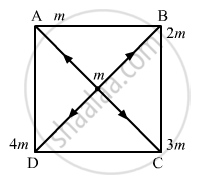Advertisements
Advertisements
Question
Four particles having masses m, 2m, 3m and 4m are placed at the four corners of a square of edge a. Find the gravitational force acting on a particle of mass m placed at the centre.
Solution

\[\text { Force due to the particle at A }, \overrightarrow{F}_{OA} = \frac{G \times m \times m}{{OA}^2}\]
\[\text { Let OA } = r\]
\[ \therefore \overrightarrow{F}_{OA} = \frac{G \times m \times m}{r^2} \]
\[\text { Here }, r = \sqrt{\left( \frac{a}{2} \right)^2 + \left( \frac{a}{2} \right)^2} = \frac{a}{\sqrt{2}}\]
\[\text { Force due to the particle at B }, \overrightarrow{F}_{OB} = \frac{G \times m \times 2m}{r^2}\]
\[\text { Force due to the particle at C }, \overrightarrow{F}_{OC} = \frac{G \times m \times 3m}{r^2}\]
\[\text { Force due to the particle at D }, \overrightarrow{F}_{OD} = \frac{G \times m \times 4m}{r^2}\]
\[\text { Now, resultant force }= \overrightarrow{F}_{OA} + \overrightarrow{F}_{OB} + \overrightarrow{F}_{OC} + \overrightarrow{F}_{OD} \]
\[ = \frac{2Gmm}{a^2}\left[ - \frac{\overrightarrow{i}}{\sqrt{2}} + \frac{\overrightarrow{j}}{\sqrt{2}} \right] + \frac{4Gmm}{a^2}\left[ \frac{\overrightarrow{i}}{\sqrt{2}} + \frac{\overrightarrow{j}}{\sqrt{2}} \right]\]
\[ = \frac{6Gmm}{a^2}\left[ \frac{\overrightarrow{i}}{\sqrt{2}} - \frac{\vec{j}}{\sqrt{2}} \right] + \frac{8Gmm}{a^2}\left[ \frac{- \overrightarrow{i}}{\sqrt{2}} - \frac{- \overrightarrow{j}}{\sqrt{2}} \right]\]
\[ \therefore F = \frac{4\sqrt{4}G m^2}{a^2} \stackrel\frown {j}\]
APPEARS IN
RELATED QUESTIONS
Write the answer of the question with reference to laws of gravitation.
State the universal law of gravitation.
The earth and the moon are attracted to each other by gravitational force. Does the earth attract the moon with a force that is greater or smaller or the same as the force with which the moon attracts the earth? Why?
What is the importance of the universal law of gravitation?
Calculate the force of gravitation between the earth and the Sun, given that the mass of the earth = 6 × 1024 kg and of the Sun = 2 × 1030 kg. The average distance between the two is 1.5 × 1011 m.
State two applications of universal law of gravitation.
Let V and E represent the gravitational potential and field at a distance r from the centre of a uniform solid sphere. Consider the two statements:
(A) the plot of V against r is discontinuous.
(B) The plot of E against r is discontinuous.
Two concentric spherical shells have masses M1, M2 and radii R1, R2 (R1 < R2). What is the force exerted by this system on a particle of mass m1 if it is placed at a distance (R1+ R2)/2 from the centre?
The law of gravitation gives the gravitational force between :
How will the force of gravitation between two objects change if the distance between them is:
Made four times
What is meant by the equation :
`g= Gxxm/r^2`
where the symbols have their usual meanings.
At what height above the earth's surface would the value of acceleration due to gravity be half of what it is on the surface? Take the radius of earth to be R.
What does a force do in the following case?
You twist a piece of rubber.
State Newton's law of gravitation. What is the difference between:
g and G?
Solve the following problem.
Find the gravitational force between the Sun and the Earth.
Given Mass of the Sun = 1.99 × 1030 kg
Mass of the Earth = 5.98 × 1024 kg
The average distance between the Earth and the Sun = 1.5 × 1011 m.
State the universal law of gravitation and derive its mathematical expression.
Give the applications of universal law gravitation.
For the weight of body of mass 5 kg to be zero on equator of the earth, angular velocity of the earth must be (The radius of earth = 6400 km, acceleration due to gravity = 10 m/s2).
Choose the wrong option.
Molecules in air in the atmosphere are attracted by gravitational force of the earth. Explain why all of them do not fall into the earth just like an apple falling from a tree.
The gravitational force between a hollow spherical shell (of radius R and uniform density) and a point mass is F. Show the nature of F vs r graph where r is the distance of the point from the centre of the hollow spherical shell of uniform density.
